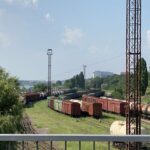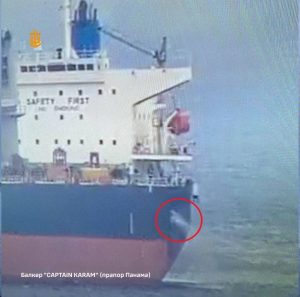Train to the sea: what’s wrong with the railway to the ports of Ukraine
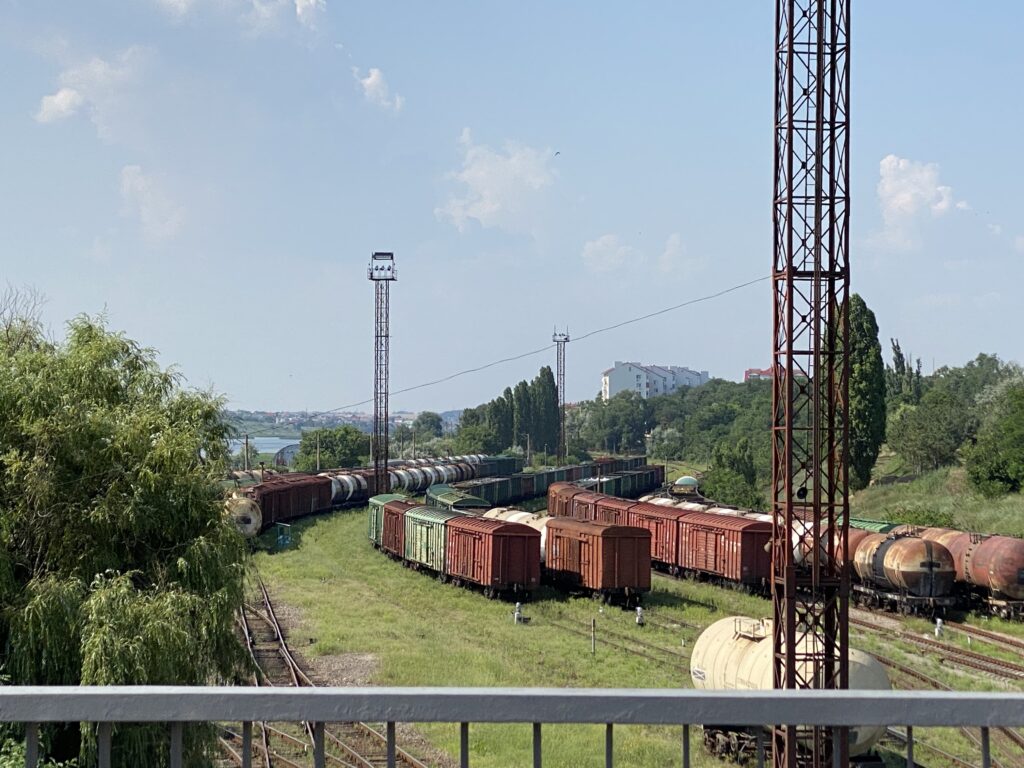
Representatives of the transport business and experts are now actively discussing the initiative of Ukrzaliznytsia (Ukrainian Railways) to increase tariffs for cargo transportation. UZ intends to impose the tariffs already from September 1st, 2021.
And, if this happens, the railway monopoly will be able to receive additional revenues in the amount of UAH 1.783 billion (USD 65.2 million) by the end of this year and about UAH 10 billion (USD 366 million) in 2022.
“We have to stop subsidizing certain types of cargo due to the existence of low class rates. The lack of financial resources in recent years should finally be directed to the benefit of the company. In the coming years, we must ensure a large-scale repair of infrastructure throughout the country, reconstruct not dozens, but hundreds of kilometers of tracks, electrical networks and other facilities, modernize locomotives and wagons. All of these investments are critically necessary in order to provide high-quality services to the business,” explains the acting Head of the Board of UZ Ivan Yurik.
But so far, the new tariffs of Ukrzaliznytsia, their validity, as well as the intentions of the management of UZ to invest funds received from shippers in the development of the company are just a project and a subject of subsequent discussions by experts.
A number of difficulties also arise with the implementation of a still pilot project with admission to the railway of the so-called private traction – locomotives that do not belong to UZ. However, it is important not only who will carry the cargoes, but also on which railroads.
In this regard, USM decided to “unscramble” the current problems in this area, moreover, at the junction of two industries – railway and port.
The fact that there is a problem in the interaction of the two modes of transport is recognized even at the state level. In Ukraine, there is an imbalance between the development of port facilities and the port infrastructure – roads and railways. It means, the ports themselves are developing faster than the roads, railways and port stations are being modernized, as stated in the Port Industry Development Strategy till 2038.
Heart of the matter
This document, approved by the Cabinet of Ministers, declares that the development of ports and railways should be “harmonized” and brought into compliance with national and regional infrastructure development programs.
“Port railway stations were designed in Ukraine primarily to accept imported cargo, which prevailed over export, – explained Raivis Veckagans, head of the Ukrainian Sea Ports Authority in 2019. – The current situation has changed to the opposite: exports in Ukrainian ports is equal for almost three quarters of transshipment. The modernization of railway stations lags behind the reorientation of freight flows and an increase in the freight nomenclature, which complicates logistics. “
Let’s analyze the situation in detail.
Read also: Ports and roads in Ukraine: a complex equation with many unknowns
Plus electrification
Probably the most problematic section of the railway, which delivers cargoes to ports, is the Dolinskaya – Mykolaiv – Kolosovka section. This highway, through which the cargoflow goes to the ports of Mykolaiv and Big Odesa, is still not electrified and in some sections is single-track. This state of affairs significantly limits the throughput of this section of the route, and, accordingly, the cargo turnover in ports. This is despite the fact that the section is part of the Trans-European Transport Network (TEN-T) within Ukraine.
To solve the problem, it is necessary to electrify 148 km of the railway, equip more than 111 km of a new railway track.
In spring, Deputy Finance Minister Aleksander Kava has announced that the project for electrification of the site would start in 2021. It is planned to finance the work with loans from the European Investment Bank and the European Bank for Reconstruction and Development. The required amount of funds is about 366 million euro (including VAT). For a loan of 150 million euros from the EBRD, Ukrzaliznytsia has already received state guarantees.
However, in June 2021, during the MINTRANS forum, Sergey Nikulin, the director of the regional branch of the Odesa Railway UZ, announced that electrification at the Dolinskaya-Mykolaiv-Kolosovka section would begin not earlier than in 2022. And this year UZ only plans to come to a decision about the general contractor for the project.
The Head of the Regional Railways believes that the implementation of the project will have a positive effect on the cargo turnover in the ports.
“Nearly all ports require much more processing capacity than we currently have. And this is just a good reason for investment promotion and developing the incoming infrastructure,” Nikulin noted.
“The implementation of the electrification project will allow Ukrzaliznytsia to increase its capabilities in the transportation of export cargo, and this is grain, ore cargo, fuels and others, to the ports of Mykolaiv. Transportation by electrified directions for us means a reduction in the self-cost and an increase in throughput, for Ukraine it means an environmental improvement, preserving and relieving pressure on the highways,” – the acting Head of the Board of UZ Ivan Yurik said in April 2021.
Troubles with railway infrastructure exist not only in this important trunk section, but in many port cities of Ukraine.
Controversial issue
In Mykolaiv, the situation is interesting and, to an extent, even conflicting. On the one hand, it is necessary to ensure the cargo flow to the ports (in the current season, the major volume of export grain can go there), on the other, the interests of the inhabitants of the Korabelny district of the city must be taken into account. After all, the railway (as well as the flow of bulk-grain lorries) runs through the residential area.
In the General Plan of the city of Mykolaiv, that has been approved back in 2009, in order to reduce cargo flows through residential area, it was envisaged to build a new railway line, which should go along the city border (but not through the Korabelny district). However, the implementation of this project has not even begun, since in order to construct a new railway line, it is necessary to solve the issue with the owners of the lands through which it will pass. However, there are no solutions yet. This is the response of the Mykolaiv Regional State Administration to the collective appeal of the inhabitants of the Korabelny district.
They also turned to the management of the Odeska Zaliznytsia regional branch of Ukrzaliznytsia JSC, and there (after receiving an official response from the Regional State Administration) they were able to provide their existing schemes for the possible laying of a new railway line with calculations from 2013. But these are just diagrams.
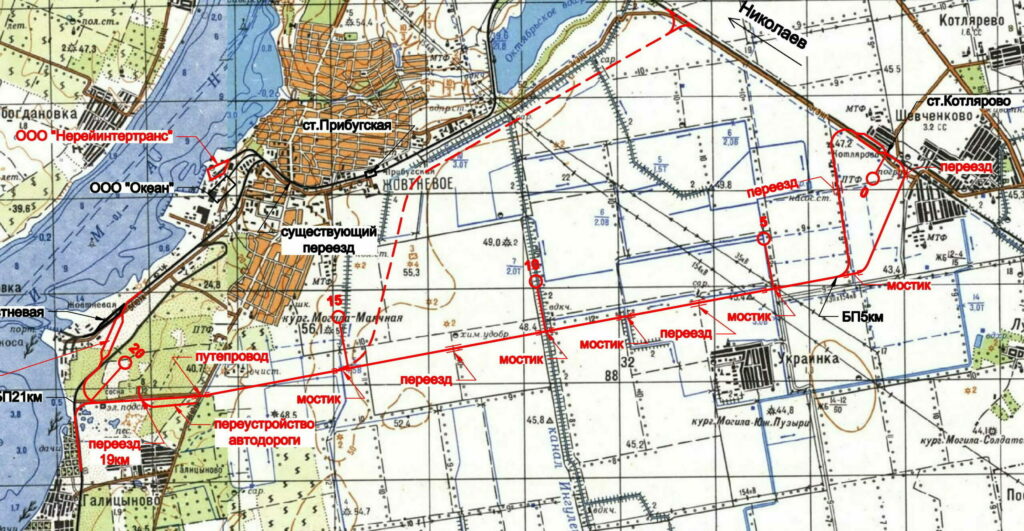
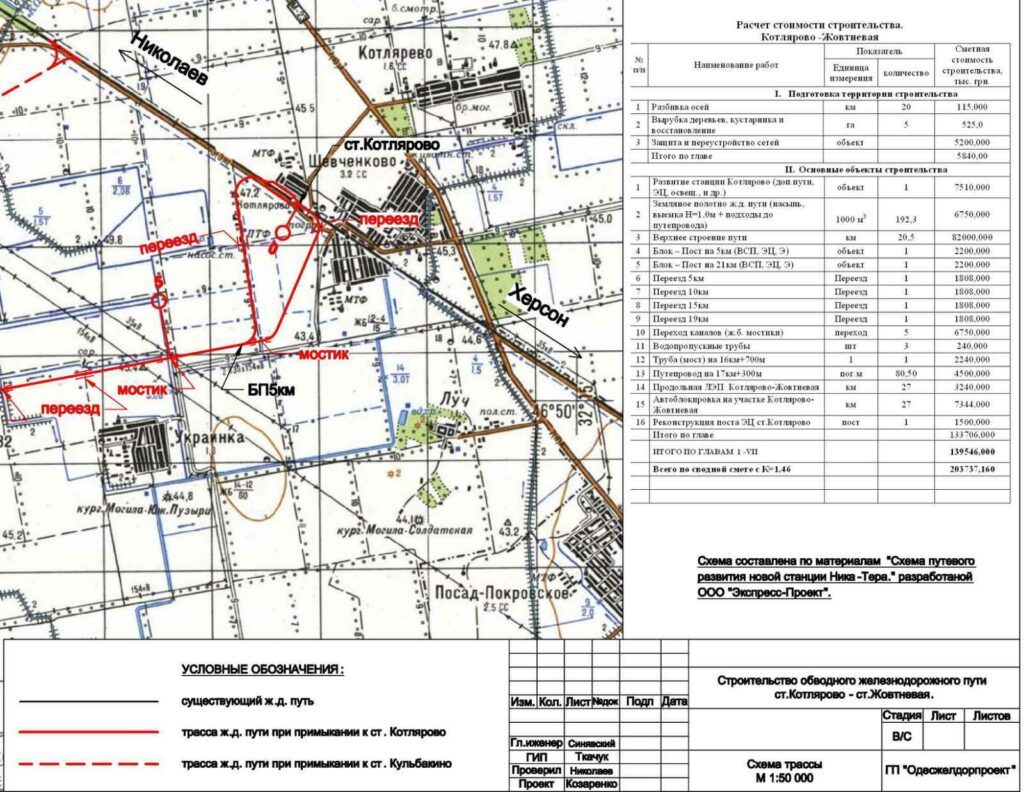
– The PFS was not developed then, but there were front-end engineering studies. Initially, Nika-Tera (a grain terminal in the port of Mykolaiv) was ready to finance the construction of a bypass railway line. But later it turned out that many issues are about the unsoldered areas. “Nika-Tera” then abandoned this idea … – they said in the Odesa branch of “Ukrzaliznytsya”.
At 2013 prices, the cost of construction of a new line exceeded UAH 200 million (USD 7.3 million).
In addition to this problem, the Odesa Railway notes the need to carry out such work to improve the delivery of cargoes to the port of Mykolaiv:
– construction of additional receiving-and-departure tracks in the Priem park, the Mykolaiv-Rudny park and the sorting yard at the Mykolaiv-Gruzovoy station;
– construction of 4 additional sorting tracks, overhaul and lengthening of the existing tracks of the Oktyabrskaya station.
Back in 2019, it has been assumed that work on the Mykolaiv-Gruzovoy station would be carried out with the use of investors – port operators of the Mykolaiv branch of the State Enterprise “USPA” (Ukrainian Sea Ports Authority). It was planned that the work performed would increase the processing capacity of the port station.
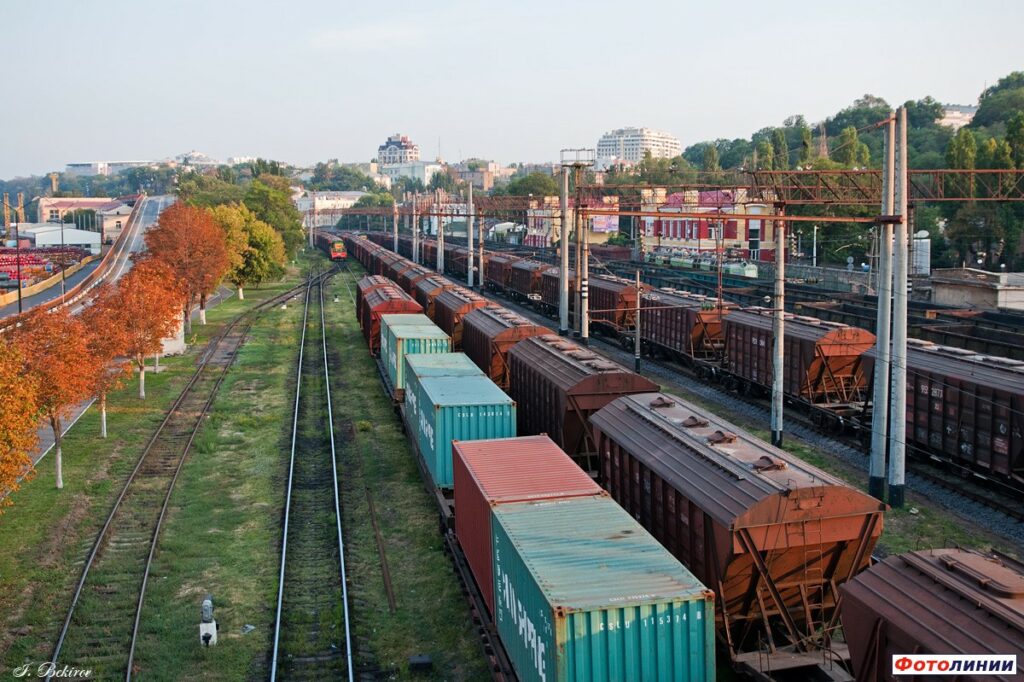
What do the port workers say?
As Ruslan Oleinik, Head of the SE «Olvia Stevedoring Company», explained, at least 80% of the cargo that goes to this port is delivered by railway transport.
– There is definitely a need to increase the capacity of port stations. Taking into account the plans for the development of all terminals located in our port, the capacity of the stations must be doubled. Now there is enough throughput capacity. Plus we have the Nika-Terra terminal nearby, they made a small station for themselves. Therefore, we more or less cope, there were no congestions at the station yet. But, taking into account all plans for the future, the station will also have to be developed, – says Ruslan Oleinik.
According to him, there is also a need for the construction of a new line in order to make the supply of cargoes reversible, from the Mykolaiv-Gruzovoy station to the Mykolaiv-Zhovtneve station.
Another large grain port terminal in Mykolaiv – Evrovneshtorg – in 2020/21 MY received about a million tons of cargo by rail, 48% of which arrived at the terminal in the past marketing year, director of terminal Sergei Gunko told USM.
“On the one hand, our railway station is terminal and one of the most powerful, but it is designed for 700 – 800 wagons per day. The Nika-tera terminal takes 300-350, we take 200-250, the rest – to all other terminals. Last season, active shipments by rail began, but in the “manual” mode, UZ has limited the possibility of confirming wagons to the station. We fought with them for a couple of weeks, and restored agreements,” says Gunko.
According to him, the company is “happy with huge harvests”.
“We have improved cargo acceptance by 15-20% thanks to internal dispatching. We are building capacities, which are equipped with a shunting device, for additional railway discharging, for the supply of 12 wagons. This is necessary to increase the throughput to 280 wagons per day. Now we have 200. In practice, we accept up to 120 wagons through 1 track per day, through two tracks – 200,” explained Gunko.
“In addition, now Odesa Railway is studying the possibility of increasing the throughput capacity of the Mykolaiv-Zhovtneve station by one and a half to two times. Mykolaiv is a port city, and ports are the drivers of the city’s development. The use of existing capacities due to dispatching, routing, additional locomotives, new railway tracks and reconstruction of stations will allow reaching a new level of wagon handling. We are now the number one region in Ukraine in terms of grain cargo. And delivery to ports by rail is minimal in cost. Therefore, the desire of UZ to study this issue is a positive moment,” says the director of the grain terminal “Evrovneshtorg”.
Mr. Gunko spoke about plans to build a new railway line bypassing the residential Korabelny district of Mykolaiv: “I do not see an opportunity to buy out agricultural land. This is a thousand of land owners. Until the state buys out the plots by force, there is nothing to talk about”.
Odesa question
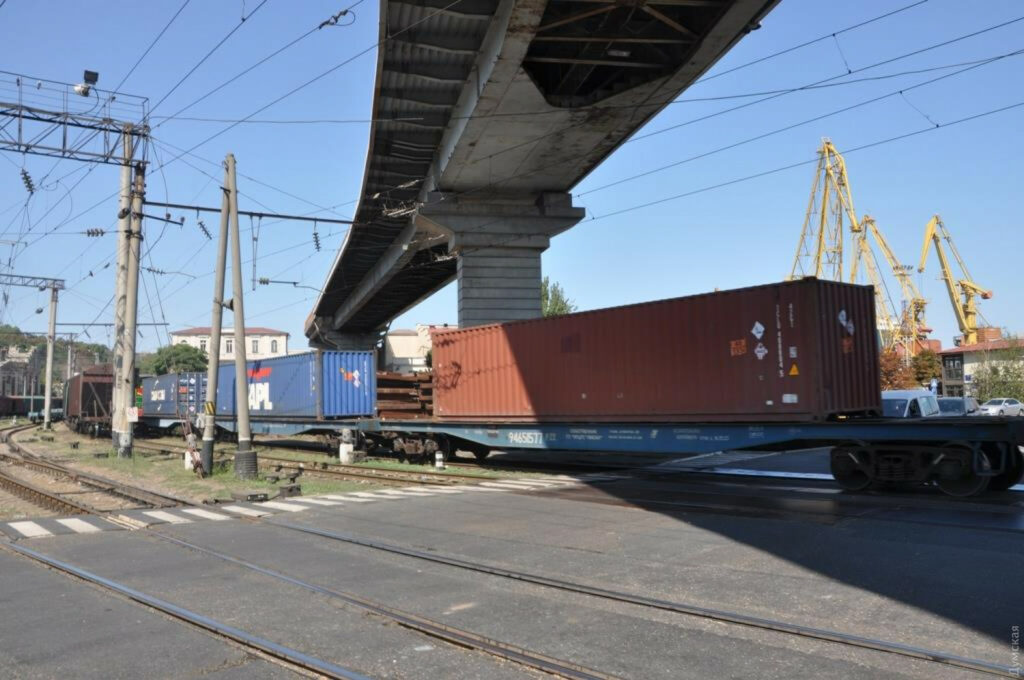
At the same MINTRANS forum, Sergey Nikulin, the director of the regional branch of the Odesa Railway UZ, said that in the Odesa region, in order to improve the connection of railway ports, it is planned to:
– reconstruction of the Station Park of the Odesa-port station;
– reconstruction and laying of additional tracks of the rear berthing yard at the Chornomorsk-port station;
– construction of additional tracks in the receiving and departure, sorting yards of Beregovaya station and laying of additional main tracks on the Chernomorskaya-Beregovaya station-to-station block;
– performance of works on the reconstruction of the station and the hill complex at the Razdelnaya station.
And the Strategy for the Development of Ukrainian Ports also provides for the construction of an additional railway entrance to the Odesa-Port station.
By the way, in 2019, a working group was organized consisting of representatives of stevedoring companies, specialists from the USPA and the regional branch of the Odesa Railway. And the preparatory work began on the implementation of the project for the reconstruction of the station park of the Odesa-Port station. At the expense of stevedoring companies, design estimates were then developed.
The fact pattern is that there is a need to equalize the situation with the imbalance in the processing capacity. According to UZ data released in 2019, all stevedoring companies in the Odesa port can handle 1,300 wagons per day, while the Odesa-Port station has a capacity of only 800 wagons.
Earlier, the director for commercial work and logistics of UZ Irakli Ezugbaya has reported that in 2021 Ukrzaliznytsia plans to develop the infrastructure of port stations and access roads to them at its own expense to increase their throughput.
“In Odesa, in cooperation with the USPA (Ukrainian Sea Ports Authority), we are trying to reorganize the traffic so that the throughput capacity of the stations is increased. There is a plan to lay more station tracks, and we came up with an initiative that Ukrzaliznytsya can arrange it using funds of 2021 budget.. I believe that infrastructure companies in ports and cargo owners should not be tasked with investing in the railway, and if they don’t invest, then we will not be able to carry cargo. If UZ sees that it is necessary to improve the throughput, she has to do it for its investments,” Ezugbaya said.
He believes that private investors can build their own new access roads leading to the existing stations “Ukrzaliznytsya” at their own expense.
“But on the existing infrastructure, UZ should not require additional investments from anyone and should invest itself due to the tariff for the transportation of cargo,” Ezugbaya emphasized.
Also, according to him, in 2021 it is planned to add two tracks at the Beregovaya station in the port of Pivdenny and bring the throughput capacity towards the port of Olvia in line with the planned increase in cargo traffic.
“In the direction to the Beregovaya station, there is a single-track section 5 km long, which is now the most restrictive. There the roadbed has already been made, but for some reason there is no railway. This is a task for our infrastructure sector, so that this is done due to the 2021 budget, and the throughput capacity is increased. In the direction of Mykolaiv and Olvia, the closed tracks at the stations have already been restored, and at this stage we see that we have sufficient throughput for the planned cargo turnover for 2021. Although, we see an investor in Olvia who has taken the port on a concession and is ready to increase its throughput capacity. We have signed a memorandum with them, in which we ask to clarify the throughput – how many pairs of trains should pass this direction. As soon as we receive this letter, we will make every effort to organize adequate throughput and transportation of cargoes at the expense of UZ,” said UZ representative.
There is also a more or less recent example of private investment in this area. At the beginning of 2021, Euroterminal has completed the construction of an access railway connecting it with the port of Odesa.
As the company has noted in its press-release after the completion of construction, the new railway line “solves the problem of unequal possibilities for the throughput of the railway lines of the port and the Odesa-port station. This discrepancy is felt to the greatest extent in spring and autumn, during the maximum traffic, when grain is exported from the terminals of the port of Odesa ”.
Donetsk knot
Since 2014, the port of Mariupol has lost access to the Donetsk railway junction and the shippers had to “change” to motor transport. In this regard, UZ has launched a project to modernize and electrify sections of the Zaporozhye – Kamysh – Zarya – Volnovakha railway.
As a result, it was possible to increase the throughput of the line from 14 to 24 pairs of trains per day, but this is still not enough: the route is used to deliver goods not only to ports, but also to metallurgical enterprises in the region, as well as for passenger traffic.
However, the project is still at the stage of implementation and its completion should be an increase in the throughput capacity of the Zaporozhye – Pologi – Kamysh – Zarya – Volnovakha – Mariupol section up to 40 pairs of trains per day.
Port without railway
The railway connection could revive the currently idle port of Skadovsk. So, in any case, it is said in the same strategy for the development of ports in Ukraine. But the question of creation of this line was never seriously considered. Including because Skadovsk is a city with the status of a resort of state importance, and the port on both sides borders on beaches. In general, the railway is out of place here.
Opinions of experts

Olga Kopiyka, Co-Chair of the Logistics Committee of the European Business Association, Deputy Director of the Legal Department of Bunge:
– There is a need for ports to increase the capacity of access railways and port railway stations. However, each port has its own situation and needs for increasing. As for Mykolaiv, such a need exists and a number of projects in this regard have been developed by private companies. However, today these are only projects, far from implementation. The matter is, among other things, in their financing. If we are talking about some big project, then UZ, obviously, expects financing from a private investor. When the project is carried out in the interests of one entity (port operator / terminal owner), then the issue is easier to resolve. However, in cases where the project provides for the development of the entire port or cargo area (beneficial to all or part of the port / to all or a number of port operators / terminal owners), then questions arise: how, in what form, by what mechanism to go, how to provide for co-investment, who participates in what volume, and so on. The current legislation does not provide for a specific mechanism for such cases. However, such a mechanism can be developed and for this it is enough to have a resolution of the Cabinet of Ministers of Ukraine and it is not necessary to amend the laws of Ukraine or adopt new ones. After all, it may take much longer than the adoption of a regulatory legal act by the Cabinet of Ministers of Ukraine.

Yuri Shchuklin, member of the logistics committee of the European Business Association, founder of the transport and logistics company Zertek:
– Is there a need to increase the capacity of access railways to ports? Naturally, any healthy business entity has ambitions to capture a large market share. Those ports and terminals are capable of developing, increasing the throughput capacity of port stations and access roads, which claim a larger cargo flow from the existing one, or a larger market share. For example, COFCO terminal can accept 3 trains a day, and if this is in line with their plans and goals, then there is no economic feasibility to invest.
An increase in the existing capacity for the current volume of cargo will also not bring additional profit to Ukrzaliznytsia. Unless, personally, to some of its functionaries, for lobbying for the creation of competitive advantages for one of the market participants.
Expanding capacity, building track development should not be at the expense of the state and taxpayers using other ports, other modes of transport, but at the expense of private investors who benefit from such expansion. For example, on the principles of public-private partnership.
Huge plans
From all that has been described above, the conclusion suggests itself that it is a long-overdue necessity, rather than a pinpoint, but a large-scale modernization of port stations and railways in accordance with the plans for the development of ports. It is recognized by both representatives of the port industry and UZ.
However, the railway workers do not have their own funds for the implementation of these projects, which makes it necessary to search for ways of cooperation with business in the framework of public-private partnerships. Or attracting borrowed funds from international financial organizations, as in the case of the reconstruction and electrification of the Dolinskaya – Mykolaiv – Kolosovka railway section.
It is also necessary to coordinate actions for the development of the port railway network with plans for the development of territories and the interests of local communities, taking into account, for example, the sad experience of Mykolaiv.
